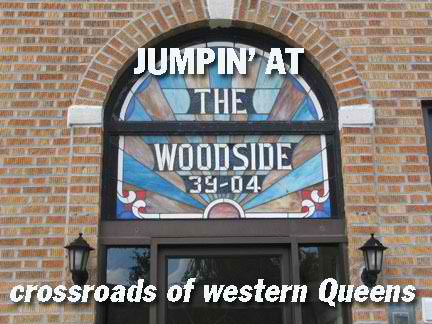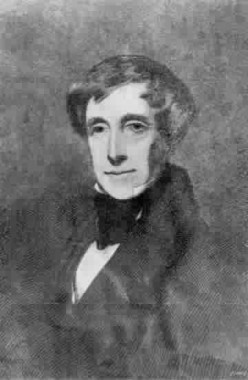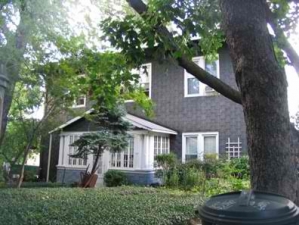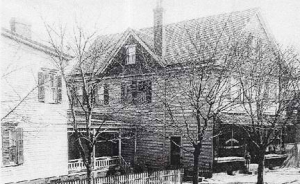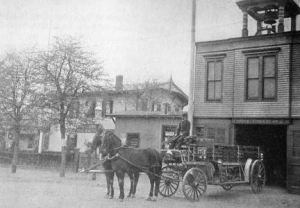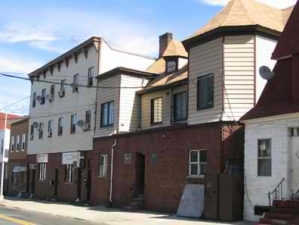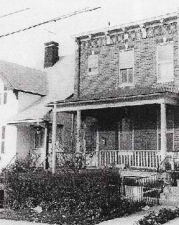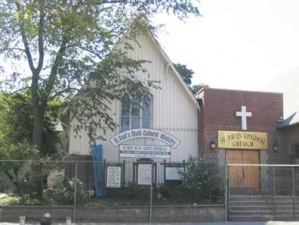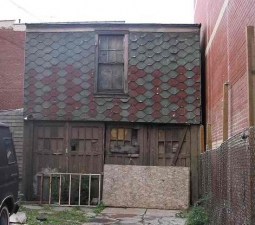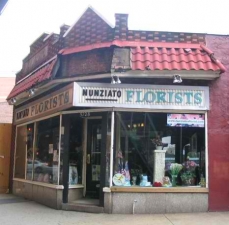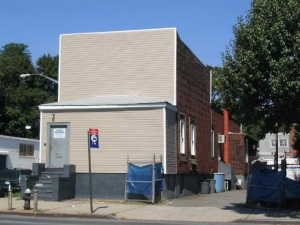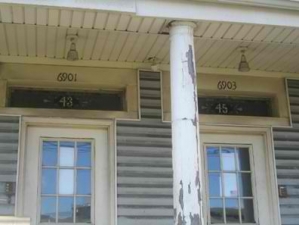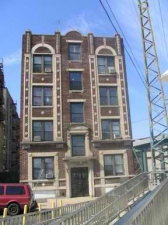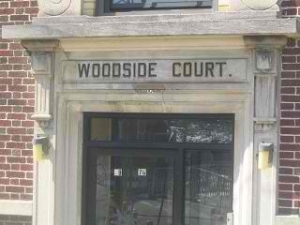By CHRISTINA WILKINSON
IN THE 17th and 18th centuries, the area known today as Woodside was filled with swamps, meadows, ponds and forests. A few colonial roads leading from the area’s waterways were forged through by those on their way to better places. A small number of brave souls decided to settle along the way. They had to fend off attacks by wolves, marauding Indians and deadly diseases on a daily basis. Suicide and infant mortality were high, life expectancy was short.
No, Woodside isn’t named for Count Basie‘s 1938 smash — or vice versa, as far as we know — but it’s got a long and varied history…
You Better, You Betts
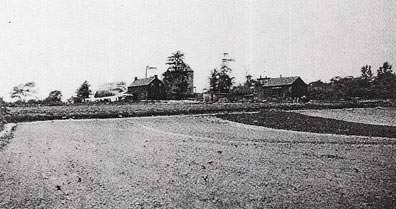 Betts farm, late 1800s. Photo by Eugene Armburster
Betts farm, late 1800s. Photo by Eugene Armburster
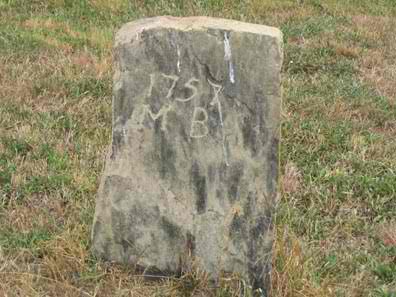 Mary Betts’ gravestone showing death date in Betts Cemetery, a part of Mount Zion Cemetery
Mary Betts’ gravestone showing death date in Betts Cemetery, a part of Mount Zion Cemetery
Captain Richard Betts was a settler from England who was opposed to Dutch rule. He along with other male settlers obtained a governor’s license to purchase Middleburg (later called Newtown) from the Indians in 1656. That same year he bought 120 acres near today’s 58th Street and 54th Avenue. He was a farmer, but in later years served as the sheriff of Long Island (1678- 1681).
Richard Betts lived to be 100 years of age, and there is a legend that says he dug his own grave a few days before dying in 1713. His descendants lived in the house until 1877; the home was razed in 1899. The Betts Avenue incinerator occupies a good portion of the property now. The family’s graveyard has survived to the present and sits within Mount Zion Cemetery. The oldest gravestone dates from 1757. 58th Street was formerly called ‘Road to English Kills’ and later, ‘Betts Avenue,’ after the family. More of Betts Cemetery appears on FNY’s Mount Zion page.
Another Early Settler Family
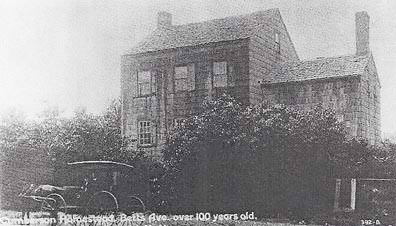 Cumberson House ca. 1900. The house stood on Betts Avenue (58th Street) at about today’s 43rd Avenue. Photo: Queens Borough Hall)
Cumberson House ca. 1900. The house stood on Betts Avenue (58th Street) at about today’s 43rd Avenue. Photo: Queens Borough Hall)
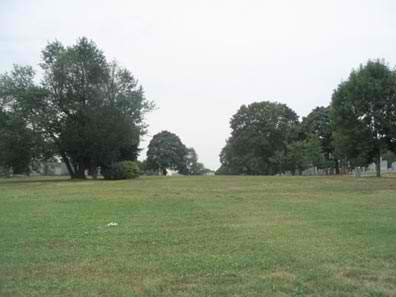 Cumberson Cemetery, bordering 58th Street and Queens Blvd.
Cumberson Cemetery, bordering 58th Street and Queens Blvd.
The Cumberson family were neighbors of the Betts family and lived farther north on Betts Avenue, near today’s Queens Boulevard. Their house was built in 1761. It was plundered by the British during the Revolution and later rebuilt. The Cumbersons ran a small farm and tannery on their property and lived in the house until 1900, when the above photo was taken. The house stood until 1920.
The family’s cemetery is still intact, but no headstones remain. The Cumbersons rest in an unmarked preserved area within the northeastern corner of New Calvary Cemetery at Queens Boulevard and 58th Street.
Woodside’s Ancient Roads
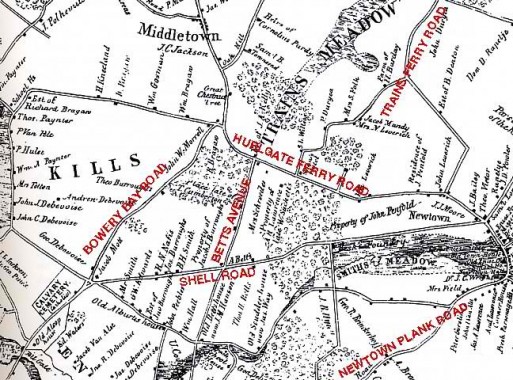 Your webmaster here, interrupting Christina for just a moment to show you his extraordinary property map from 1852 (found in Woodside: A Historical Perspective 1652-1994 by Catherine Gregory). Most of the roads in this map are either still there or have left some trace.
Your webmaster here, interrupting Christina for just a moment to show you his extraordinary property map from 1852 (found in Woodside: A Historical Perspective 1652-1994 by Catherine Gregory). Most of the roads in this map are either still there or have left some trace.
Bowery Bay Road: formerly the main route from what is now Sunnyside to Bowery Bay, where the Rikers Island Bridge (leading to the penitentiary) is now. Today, Celtic Avenue in southern Sunnyside and Hobart Street between 28th and 31st Avenues near the BQE are the only traces of this once-lengthy wagon path.
Shell Road: once paved with oyster shells, this ancient trace went from Newtown Creek to the heart of Newtown, today’s Elmhurst, at Broadway and Elmhurst Avenues. Today its route is shared by Laurel Hill Blvd. and 45th Avenue.
Betts Avenue, as Christina has mentioned, is the former Road to English Kills, later, Betts-Covert Avenue (after another old landholding family in the area) and finally Betts Avenue. It was given the name 58th Street in the 1920s.
Newtown Plank Road, a connection to Williamsburg, was later known as Grand Street (it still is in Brooklyn) and later, Grand Avenue. Note the small bend in a side road just above the N in Newtown. That, too, is still there, just below today’s Calamus Avenue and 72nd Street. Some of today’s maps call it Old Lane, since it’s been there a long time. The city has not marked it to date.
Trains Meadow Lane, laid out as early as 1672, was formerly the only main road through the swampy meadow that is today’s Jackson Heights. When the area was built up and a street grid introduced, the old wagon path fell into disuse. Of all of Western Queens’ old roads, this has left the fewest remnants. 35th Road between 69th and Leverich Street was a part of it. Another clue is a house turned cater-corner to the grid on 82nd Street: it faced Trains Meadow Road when built.
 For ancient road sleuths, a good clue to a road’s antiquity is if it takes twists and turns amid the prevailing grid. Woodside Avenue does just that, rolling SE, S, SE and then directly east from Northern Boulevard to Broadway in Elmhurst. Just south of Northern Boulevard (in colonial times, the boulevard was an Indian trail and later, a toll road called Jackson Avenue) Woodside Avenue moved through a nearly impassible swampy area (known as Wolf Swamp) and its curving route apparently follows the only dry land to be found in the area. The road led to a network of roads leading to a ferry at Hell Gate at the East River and so carried a variety of names reflecting this: Hell Gate Road, Hurl Gate Road or Hurl Gate Ferry Road. In the late 19th Century it received its more prosaic moniker.
For ancient road sleuths, a good clue to a road’s antiquity is if it takes twists and turns amid the prevailing grid. Woodside Avenue does just that, rolling SE, S, SE and then directly east from Northern Boulevard to Broadway in Elmhurst. Just south of Northern Boulevard (in colonial times, the boulevard was an Indian trail and later, a toll road called Jackson Avenue) Woodside Avenue moved through a nearly impassible swampy area (known as Wolf Swamp) and its curving route apparently follows the only dry land to be found in the area. The road led to a network of roads leading to a ferry at Hell Gate at the East River and so carried a variety of names reflecting this: Hell Gate Road, Hurl Gate Road or Hurl Gate Ferry Road. In the late 19th Century it received its more prosaic moniker.
One Moore time
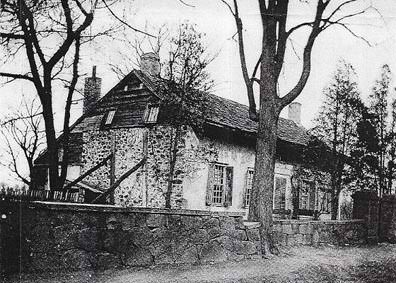 Moore farmhouse, 32nd Avenue and 54th Street, just before demolition in 1901. Geipel
Moore farmhouse, 32nd Avenue and 54th Street, just before demolition in 1901. Geipel
Rev. John Moore was an independent minister and in 1656 became the first minister in the town of Middleburg. He died the following year. His son, Captain Samuel Moore, was granted 80 acres near Broadway and 83rd Street, where he built a house in 1661, now the site of the Moore Homestead Park. Rev. Moore’s grandson, Captain Samuel Moore, Jr., built a house (above, left, ca. 1900) at 32nd Avenue and 54th Street in 1705 and owned 100 acres of surrounding farm and woodland. The Moores were Loyalists, and in 1776 after the Battle of Long Island, Sir Henry Clinton set up his HQ at the original Moore Homestead while Redcoats occupied area homes for the next 7 years.
 The Newtown Pippin, a favorite fruit of George Washington, Thomas Jefferson, Benjamin Franklin and Queen Victoria, was first harvested on the original Moore property in 1759 by Gersham Moore, a direct descendant of Rev. Moore. The original tree died in 1805 after many decades of overcutting for propagation, and sometime in the 19th century, pippin trees disappeared from Newtown completely. The First Presbyterian Church of Newtown, Rev. Moore’s congregation, planted new seedlings in their church garden in 2002 for their 350th anniversary, bringing the apple back to its area of origin. In 2004, the Newtown Pippin was declared the official apple of New York City.
The Newtown Pippin, a favorite fruit of George Washington, Thomas Jefferson, Benjamin Franklin and Queen Victoria, was first harvested on the original Moore property in 1759 by Gersham Moore, a direct descendant of Rev. Moore. The original tree died in 1805 after many decades of overcutting for propagation, and sometime in the 19th century, pippin trees disappeared from Newtown completely. The First Presbyterian Church of Newtown, Rev. Moore’s congregation, planted new seedlings in their church garden in 2002 for their 350th anniversary, bringing the apple back to its area of origin. In 2004, the Newtown Pippin was declared the official apple of New York City.
Another Moore heir became famous for a Christmas poem written for his wife and children. In 1822, A Visit From Saint Nicholas, today known as The Night Before Christmas, was written by Clement Clarke Moore (above, right). He lived at his family estate in Manhattan, called Chelsea. [The neighborhood of Chelsea was named after this estate.] Some historians believe that Moore’s inspiration for the poem was the memory of childhood Christmases spent at his grandparents’ Newtown home. However, others dispute his authorship altogether.
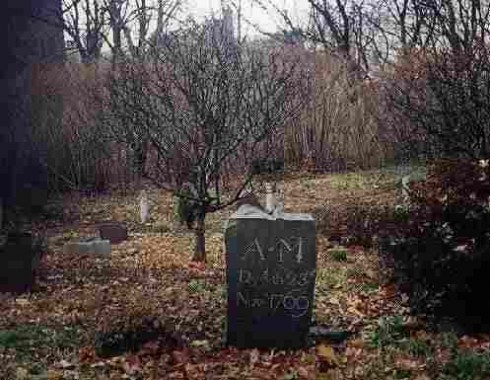 Moore-Jackson Cemetery. Augustine Moore (“dyed the 23rd Novr. 1769”) is front and center.
Moore-Jackson Cemetery. Augustine Moore (“dyed the 23rd Novr. 1769”) is front and center.
John C. Jackson, architect of Northern Boulevard (formerly Jackson Avenue), married Martha Riker, Rev. Moore’s great-great-granddaughter. The family’s graveyard, Moore-Jackson Cemetery, can be found along 54th Street south of 31st Avenue. Prior to 1937, it was strewn with garbage; since the early ’90’s it has been lovingly tended to by volunteers. It’s earliest known burial dates to 1733. The cemetery is profiled on FNY’s Dead Reckoning page.
The Man Who Named Woodside
 Originally from Charleston, South Carolina, merchant John Kelly moved his young family to Newtown in 1826. The house pictured at left was their home, on what was known at the time as ‘Road to Newtown’ at Betts Avenue (58th Street). Their property was vast and it included the part of the Winfield Woods which was across the street from the house. [Winfield is now considered part of Woodside.] Photo: Queens Borough Hall
Originally from Charleston, South Carolina, merchant John Kelly moved his young family to Newtown in 1826. The house pictured at left was their home, on what was known at the time as ‘Road to Newtown’ at Betts Avenue (58th Street). Their property was vast and it included the part of the Winfield Woods which was across the street from the house. [Winfield is now considered part of Woodside.] Photo: Queens Borough Hall
Kelly’s son, John A.F. Kelly, pursued a career as a journalist and co-founded a newspaper with his sister, Maria, published out of Brooklyn. The paper was eventually bought out by theBrooklyn Times, but Kelly stayed on as a columnist.
At this time Kelly was living in Brooklyn, but he wrote a column called Letters From Woodside about life at his parents’ estate, which he called Woodside. Later in life, he moved back to the community and lived with his brother in a house around the corner from his boyhood home. Both residences are now gone. St. Sebastian’s School (1926) (see below) is there now.
 In 1860, the LIRR bought a parcel of the Kelly estate for a stationhouse. This photo of Woodside station is thought to be the oldest photo of a Queens LIRR station in existence. The depot made the area a destination instead of a stopover. The rest of the Kelly farm was bought by developer Benjamin Hitchcock, who divided it up into small land parcels. He laid out his village in 1867, and adopted the name of the Kelly estate for it, giving birth to the town of ‘Woodside.’ In 1869, a brand new rail station at 58th Street and 38th Avenue was constructed and the old station closed. The community flourished around this depot.
In 1860, the LIRR bought a parcel of the Kelly estate for a stationhouse. This photo of Woodside station is thought to be the oldest photo of a Queens LIRR station in existence. The depot made the area a destination instead of a stopover. The rest of the Kelly farm was bought by developer Benjamin Hitchcock, who divided it up into small land parcels. He laid out his village in 1867, and adopted the name of the Kelly estate for it, giving birth to the town of ‘Woodside.’ In 1869, a brand new rail station at 58th Street and 38th Avenue was constructed and the old station closed. The community flourished around this depot.
In the present Woodside Avenue station, artist Dmitri Gerakaris’ Woodside Continuum depicts this station.
 In 1915, the LIRR decided to construct a more direct rail route, which would connect with an elevated subway line. This shifted the nucleus of the town to the crossroads of 61st Street (formerly Kelly Street), the newly-constructed Roosevelt Avenue, and the newly-named Woodside Avenue (no longer called ‘Road to Newtown’ or ‘Hurlgate Ferry Road’). Compare the original station with the modern-day one. They’ve come a long way, baby!
In 1915, the LIRR decided to construct a more direct rail route, which would connect with an elevated subway line. This shifted the nucleus of the town to the crossroads of 61st Street (formerly Kelly Street), the newly-constructed Roosevelt Avenue, and the newly-named Woodside Avenue (no longer called ‘Road to Newtown’ or ‘Hurlgate Ferry Road’). Compare the original station with the modern-day one. They’ve come a long way, baby!
The following are some places of interest that were located near the old LIRR Woodside Station at 58th Street and 38th Avenue prior to 1915. The buildings are still standing, but no longer used for their former purposes.
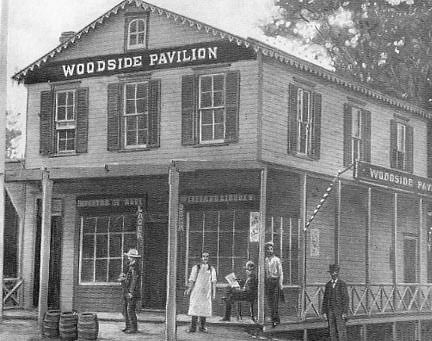 The Woodside Pavilion opened in 1877. From 1882 to 1900 it was known as Berry’s Hotel. In the 1920’s, St. Sebastian’s band used it as a practice hall. In 1936, it was used by the Woodside Democratic Club. Scene above is circa 1880. Propietor John Meyer, who also operated the Meyer Hotel (see next) is in front, with the apron. [Queens Borough Hall]
The Woodside Pavilion opened in 1877. From 1882 to 1900 it was known as Berry’s Hotel. In the 1920’s, St. Sebastian’s band used it as a practice hall. In 1936, it was used by the Woodside Democratic Club. Scene above is circa 1880. Propietor John Meyer, who also operated the Meyer Hotel (see next) is in front, with the apron. [Queens Borough Hall]
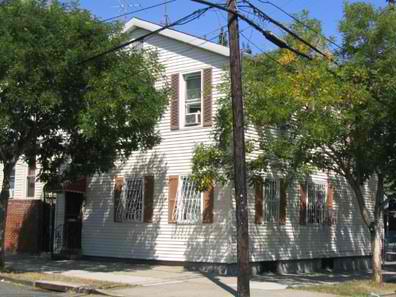 Today, the former Woodside Pavilion sits on a quiet tree-lined street (39th Avenue) next to a dead end (57th Street) and reveals no hints as to its history as a major community center.
Today, the former Woodside Pavilion sits on a quiet tree-lined street (39th Avenue) next to a dead end (57th Street) and reveals no hints as to its history as a major community center.
John G. Meyer emigrated from Germany in 1877 and became the bartender and manager of the Woodside Pavilion. He and his wife opened their own hotel in 1882. Meyer’s Hotel was built at 39th Avenue and 58th Street. Ad above, left is from 1883.
From Woodside, a Historical Perspective: 1652-1994 and originally appeared in the Newtown Register:
Built at a cost of nearly $10,000, it featured modern improvements, including baths, hot and cold water in every room, extensive heaters, and hot-air furnaces. The second floor provided lodgings for hotel guests and the Meyer family. The first floor was entirely trimmed in hardwood with yellow pine wainscotting, surmounted with black walnut moldings. Valuable paintings hung on the fresco walls. A spacious room in the rear, which could be shut off from the refreshment room by paneled sliding doors, gave privacy for public assembly. A barber shop and a liberally equipped kitchen were also in the rear. In addition, the hotel provided shelter for horses and vehicles.
In 1917, the LIRR built elevated tracks right outside the hotel, which was too close for the comfort of guests. The hotel was then converted into a 2-family residence, which it remains today.
Brothers Henry and August Borges moved to Woodside in 1876 from Manhattan and opened their own grocery store and meat market. They dissolved their partnership in 1887 and August opened his own business at 57th Street and 38th (then Howell) Avenue behind his home, constructing a passageway between the two buildings. He operated the business until he retired in 1918. He then converted the butcher shop into a residence for his daughter. Old photo above is from 1900 [taken by August Borges]. Both the Borges house and butcher shop remain standing today, and both are multi-unit private dwellings covered with lots of aluminum siding.
When first organized, Woodside Hook and Ladder Company was housed in rented quarters. By 1884, they had raised enough money to buy property and build Firemen’s Hall on 39th Avenue next to Meyer’s Hotel. The bell pictured in the rooftop tower now sits in front of St. Sebastian’s Rectory. It first hung aboard the former East River steamer, Sylvan Dell, then at the firehouse, and then in the belfry of the first St. Sebastian’s Church, opened in 1896. Photo above, left, taken in 1908: Meyer’s Hotel appears at left. [R. Leslie Smith collection]
Today, the building is a Korean church which stands in the shadow of the LIRR, and is much altered from its original design.
Otto Groeber and his family were natives of Prussia who settled in Woodside in 1870. Groeber made his living as a tailor. His house and shop combo on 58th Street north of 38th Avenue is still around, but the building is no longer used as a commercial property. Old photo above from 1900. [August Borges postcard]
In 1871, Warren H. Lamson of Boston settled in the area and built a house on 39th Avenue at 54th Street (pictured above, left). He became Woodside’s first public school teacher in 1872. His one-room schoolhouse was located in a private residence at 34-42 58th Street (above, middle, ca. 1980; above, right, 2005) until a school building was completed 6 years later. Both structures were well-maintained by their subsequent owners and remain standing today as private residences. [center photo: Jean LeGall]
St. Paul’s Protestant Episcopal Church, founded in 1874, was the first church in the village of Woodside. It is “a Carpenter Gothic building with Gothic stained glass windows, overhanging eaves, vertical siding, and multicolored roof tiles.” (Gregory, 1994) The church stands at the corner of 61st Street and 39th Avenue (above, left).
Christ Evangelical Lutheran Church on 58th Street north of Broadway opened in 1896 and conducted services in both German and English. It stands on what was the southern end of the Moore farm.
St. Paul’s suffered a devastating fire in December 2007.
At the same time that the Lutheran Church was being built, Woodside’s trolley system was being planned. Read about Tower Square and the landmark New York & Queens County Railway trolley barn at Woodside Avenue and Northern Blvd. on FNY’s Trolley Barn page. [This was the very first Forgotten NY page produced, way back in March 1999 — shows, doesn’t it? your webmaster]
20th Century Woodside
Woodside once had many flower farms and greenhouses. The Nunziato family has been in the flower business since moving to America in 1901. Nunziato Florists still stands in its original location along Roosevelt Avenue.
One member of the Nunziato clan is City Councilman Eric Gioia. His great-grandparents were the flower shop’s founders; his father and uncle run it today. Beside Gioia’s campaign office, a block east of the flower shop, an old barn holds its ground.
Jackson Social and Field Club started with 13 members in 1902. The photo above, left was taken in 1903. The club still meets at the same location on Northern Boulevard, but as you can see from the middle photo, the modern-day clubhouse has been much altered from its original state. The club today has 25 members. Baseball Hall-of-FamerWalter “Rabbit” Maranville (above, right) mantained membership here after his retirement from the big leagues. He bought a home in Woodside in the 1940’s in which he lived until his death in 1954. Rabbit made wearing a baseball cap to the side hip before the grandparents of today’s rappers were even born.
Other famous former residents of Woodside include actor Edward Burns, filmmaker Francis Ford Coppola and Schools Chancellor (and former thorn in Bill Gates’ side) Joel Klein.
Attached wooden houses with open porches are pretty scarce these days, but this beautiful holdout sits on 69th Street a block north of the 7 train.
A close look at the stained glass windows over the doors reveals 4-digit addresses sitting above the original 2-digit addresses, meaning this structure was built prior to 1915 when Queens street numbering and address conversions occurred.
Woodside Court is the oldest apartment building in Woodside. It was built in 1916 around the same time as the IRT line (#7 train) and stands next to the Woodside LIRR station on 62nd Street.
MORE ABOUT WOODSIDE, QUEENS IN WOODSIDE PART 2

